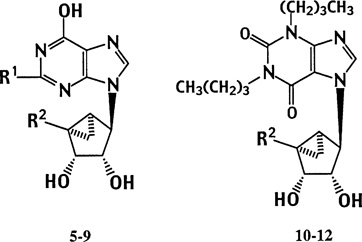Table 1.
Affinities of (N)-methanocarba analogues of 6-oxpurine ribosides in radioligand binding assays at rat A1,a rat A2A,b and human A3 receptors,c unless noted, and in other biochemical assay systemsd
 | |||||
|---|---|---|---|---|---|
| Compound | R1 | R2 | Ki (µM) or % displacement at 100 µM | ||
| rA1a | rA2Ab | hA3c | |||
| 5 MRS 1957 | H | CH2OH | < 10% | < 10% | 30 ± 10% |
| 6 MRS 1997 | H | CONHCH3 | < 10% | < 10% | 28.8 ± 5.2 |
| 7a MRS 2397d | H | CH2O–phosphate | 11 ± 1% | ||
| 7b MRS 2398d | H | CH2O–phosphate]2 dimer | 21.6 ± 0.4 | ||
| 8 MRS 1941 | NH2 | CH2OH | < 10% | < 10% | 20.5 ± 2.1 |
| 9 MRS 2351d | NH2 | CH2O–triphosphate | < 10% | ||
| 10 MRS 1971 | — | CH2OH | 2.97 ± 0.15 | < 10% | 4.35 ± 0.40 |
| 11 MRS 1998 | — | CONHCH3 | 24.4 ± 4.8 | < 10% | 1.86 ± 0.23 |
| 12 MRS 2396 | — | CH2O–triphosphate | < 10% | ||
Displacement of specific [3H]R-PIA binding to A1 receptors in rat brain membranes, expressed as Ki ± SEM or % (n = 3–5).
Displacement of specific [3H]CGS 21680 binding to A2A receptors in rat striatal membranes, expressed as Ki ± SEM or % (n = 3–6).
Displacement of specific [125I]AB-MECA binding at human A3 receptors expressed in HEK-293 cells, in membranes, expressed as Ki ± SEM or % (n = 3–5).
Selected compounds were examined in HL-60 cells for effects on calcium mobilization. Compounds 7a and 7b (100 µM) were inactive in raising intracellular calcium, while compound 9 (100 µM) caused a rise in intracellular calcium equivalent to 53 ± 18% of the effect of 1 µM UTP (n = 3).
